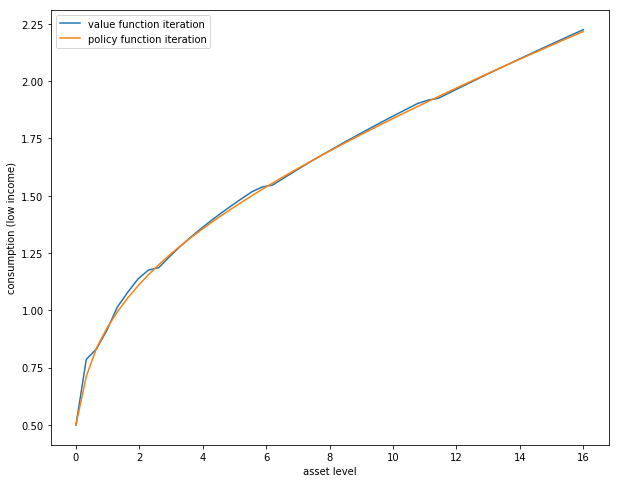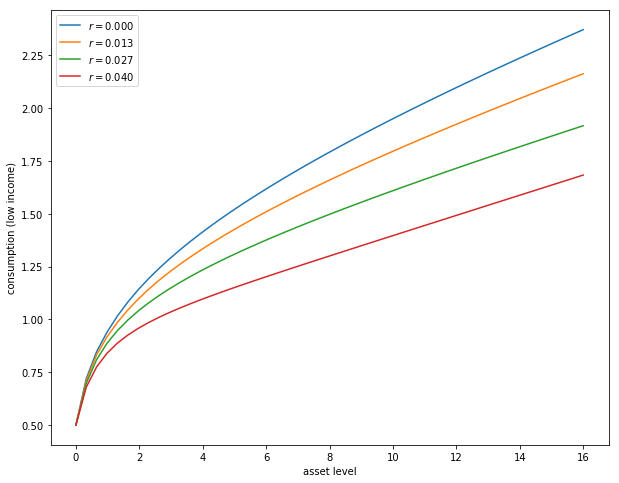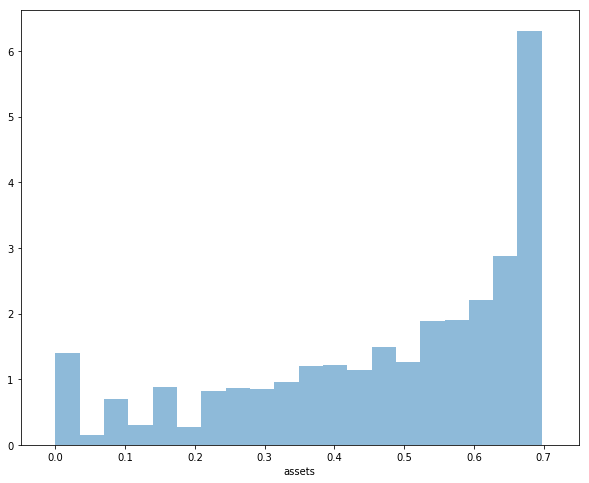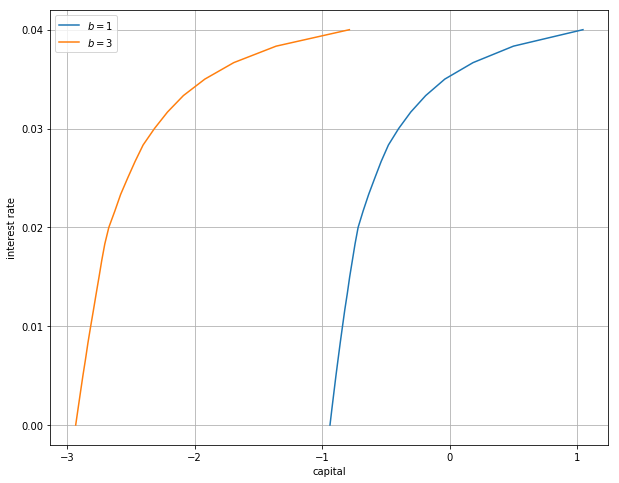41. Optimal Savings III: Occasionally Binding Constraints#
Contents
41.1. Overview#
Next we study an optimal savings problem for an infinitely lived consumer—the “common ancestor” described in [LS18], section 1.3.
This is an essential sub-problem for many representative macroeconomic models
It is related to the decision problem in the stochastic optimal growth model and yet differs in important ways.
For example, the choice problem for the agent includes an additive income term that leads to an occasionally binding constraint.
Our presentation of the model will be relatively brief.
* For further details on economic intuition, implication and models, see [LS18]
Proofs of all mathematical results stated below can be found in this paper
To solve the model we will use Euler equation based time iteration, similar to this lecture.
This method turns out to be
Globally convergent under mild assumptions, even when utility is unbounded (both above and below).
More efficient numerically than value function iteration.
41.1.1. References#
Other useful references include [Dea91], [DH10], [Kuh13], [Rab02], [Rei09] and [SE77].
41.2. The Optimal Savings Problem#
Let’s write down the model and then discuss how to solve it.
41.2.1. Set Up#
Consider a household that chooses a state-contingent consumption plan
subject to
Here
Non-capital income
This means that
The expectation of
We further assume that
The asset space is
A feasible consumption path from
the feasibility constraints in (41.1), and
measurability of
The meaning of the third point is just that consumption at time
41.2.2. Value Function and Euler Equation#
The value function
where the supremum is over all feasible consumption paths from
An optimal consumption path from
To pin down such paths we can use a version of the Euler equation, which in the present setting is
and
In essence, this says that the natural “arbitrage” relation
Interiority means that
(The lower boundary case
When
With some thought and effort, one can show that (41.3) and (41.4) are equivalent to
41.2.3. Optimality Results#
Given our assumptions, it is known that
For each
This path is the unique feasible path from
Moreover, there exists an optimal consumption function
satisfies both (41.5) and (41.6), and hence is the unique optimal
path from
In summary, to solve the optimization problem, we need to compute
41.3. Computation#
There are two standard ways to solve for
Time iteration (TI) using the Euler equality
Value function iteration (VFI)
Let’s look at these in turn.
41.3.1. Time Iteration#
We can rewrite (41.5) to make it a statement about functions rather than random variables.
In particular, consider the functional equation
where
Equation (41.7) is a functional equation in
In order to identify a solution, let
each
In addition, let
For given
where
We refer to
It is known that
The metric
Convergence in
In consequence,
By the definition of
In particular, it can be shown that the path
TL;DR The unique optimal policy can be computed by picking any
41.3.2. Value Function Iteration#
The Bellman operator for this problem is given by
We have to be careful with VFI (i.e., iterating with
In fact typically unbounded both above and below — e.g.
In which case, the standard DP theory does not apply.
Nonetheless, we can always try the popular strategy “iterate and hope”.
We can then check the outcome by comparing with that produced by TI.
The latter is known to converge, as described above.
41.3.3. Implementation#
Here’s the code for a named-tuple constructor called ConsumerProblem that stores primitives, as well as
a
Tfunction, which implements the Bellman operatora
Kfunction, which implements the Coleman operatoran
initialize, which generates suitable initial conditions for iteration
using LinearAlgebra, Statistics, Interpolations, NLsolve
using BenchmarkTools, LaTeXStrings, Optim, Plots, Random, QuantEcon
using Optim: converged, maximum, maximizer, minimizer, iterations
# utility and marginal utility functions
u(x) = log(x)
du(x) = 1 / x
# model
function ConsumerProblem(; r = 0.01,
beta = 0.96,
Pi = [0.6 0.4; 0.05 0.95],
z_vals = [0.5, 1.0],
b = 0.0,
grid_max = 16,
grid_size = 50)
R = 1 + r
asset_grid = range(-b, grid_max, length = grid_size)
return (; r, R, beta, b, Pi, z_vals, asset_grid)
end
function T!(cp, V, out; ret_policy = false)
# unpack input, set up arrays
(; R, Pi, beta, b, asset_grid, z_vals) = cp
z_idx = 1:length(z_vals)
# value function when the shock index is z_i
vf = LinearInterpolation((asset_grid, z_idx), V;
extrapolation_bc = Interpolations.Flat())
opt_lb = 1e-8
# solve for RHS of Bellman equation
for (i_z, z) in enumerate(z_vals)
for (i_a, a) in enumerate(asset_grid)
function obj(c)
EV = dot(vf.(R * a + z - c, z_idx), Pi[i_z, :]) # compute expectation
return u(c) + beta * EV
end
res = maximize(obj, opt_lb, R .* a .+ z .+ b)
converged(res) || error("Didn't converge") # important to check
if ret_policy
out[i_a, i_z] = maximizer(res)
else
out[i_a, i_z] = maximum(res)
end
end
end
return out
end
T(cp, V; ret_policy = false) = T!(cp, V, similar(V); ret_policy = ret_policy)
get_greedy!(cp, V, out) = update_bellman!(cp, V, out, ret_policy = true)
get_greedy(cp, V) = update_bellman(cp, V, ret_policy = true)
function K!(cp, c, out)
# simplify names, set up arrays
(; R, Pi, beta, b, asset_grid, z_vals) = cp
z_idx = 1:length(z_vals)
gam = R * beta
# policy function when the shock index is z_i
cf = LinearInterpolation((asset_grid, z_idx), c;
extrapolation_bc = Interpolations.Flat())
# compute lower_bound for optimization
opt_lb = 1e-8
for (i_z, z) in enumerate(z_vals)
for (i_a, a) in enumerate(asset_grid)
function h(t)
cps = cf.(R * a + z - t, z_idx) # c' for each z'
expectation = dot(du.(cps), Pi[i_z, :])
return abs(du(t) - max(gam * expectation, du(R * a + z + b)))
end
opt_ub = R * a + z + b # addresses issue #8 on github
res = optimize(h, min(opt_lb, opt_ub - 1e-2), opt_ub,
method = Optim.Brent())
out[i_a, i_z] = minimizer(res)
end
end
return out
end
K(cp, c) = K!(cp, c, similar(c))
function initialize(cp)
# simplify names, set up arrays
(; R, beta, b, asset_grid, z_vals) = cp
shape = length(asset_grid), length(z_vals)
V, c = zeros(shape...), zeros(shape...)
# populate V and c
for (i_z, z) in enumerate(z_vals)
for (i_a, a) in enumerate(asset_grid)
c_max = R * a + z + b
c[i_a, i_z] = c_max
V[i_a, i_z] = u(c_max) / (1 - beta)
end
end
return V, c
end
initialize (generic function with 1 method)
Both T and K use linear interpolation along the asset grid to approximate the value and consumption functions.
The following exercises walk you through several applications where policy functions are computed.
In exercise 1 you will see that while VFI and TI produce similar results, the latter is much faster.
Intuition behind this fact was provided in a previous lecture on time iteration.
41.4. Exercises#
41.4.1. Exercise 1#
The first exercise is to replicate the following figure, which compares TI and VFI as solution methods

The figure shows consumption policies computed by iteration of
In the case of iteration with
Consumption is shown as a function of assets with income
The following details are needed to replicate the figure
The parameters are the default parameters in the definition of
consumerProblem.The initial conditions are the default ones from
initialize(cp).Both operators are iterated 80 times.
When you run your code you will observe that iteration with
In the Julia console, a comparison of the operators can be made as follows
cp = ConsumerProblem()
v, c = initialize(cp)
([-17.328679513998615 0.0; -4.664387247760648 7.125637140580436; … ; 69.82541010621486 70.57937835479346; 70.32526591846735 71.06452735149534], [0.5 1.0; 0.8297959183673469 1.329795918367347; … ; 16.33020408163265 16.83020408163265; 16.66 17.16])
@btime T(cp, v);
244.556 μs
(8273 allocations: 331.31 KiB)
@btime K(cp, c);
312.001 μs
(15459 allocations: 612.02 KiB)
41.4.2. Exercise 2#
Next let’s consider how the interest rate affects consumption.
Reproduce the following figure, which shows (approximately) optimal consumption policies for different interest rates

Other than r, all parameters are at their default values
r steps through range(0, 0.04, length = 4)
Consumption is plotted against assets for income shock fixed at the smallest value
The figure shows that higher interest rates boost savings and hence suppress consumption.
41.4.3. Exercise 3#
Now let’s consider the long run asset levels held by households.
We’ll take r = 0.03 and otherwise use default parameters.
The following figure is a 45 degree diagram showing the law of motion for assets when consumption is optimal
# solve for optimal consumption
m = ConsumerProblem(r = 0.03, grid_max = 4)
v_init, c_init = initialize(m)
sol = fixedpoint(c -> K(m, c), c_init)
c = sol.zero
a = m.asset_grid
R, z_vals = m.R, m.z_vals
# generate savings plot
plot(a, R * a .+ z_vals[1] - c[:, 1], label = "Low income")
plot!(xlabel = "Current assets", ylabel = "Next period assets")
plot!(a, R * a .+ z_vals[2] - c[:, 2], label = "High income")
plot!(xlabel = "Current assets", ylabel = "Next period assets")
plot!(a, a, linestyle = :dash, color = "black", label = "")
plot!(xlabel = "Current assets", ylabel = "Next period assets")
plot!(legend = :topleft)
The blue line and orange line represent the function
when income
The dashed line is the 45 degree line.
We can see from the figure that the dynamics will be stable — assets do not diverge.
In fact there is a unique stationary distribution of assets that we can calculate by simulation
Can be proved via theorem 2 of [HP92].
Represents the long run dispersion of assets across households when households have idiosyncratic shocks.
Ergodicity is valid here, so stationary probabilities can be calculated by averaging over a single long time series.
Hence to approximate the stationary distribution we can simulate a long time series for assets and histogram, as in the following figure

Your task is to replicate the figure
Parameters are as discussed above
The histogram in the figure used a single time series
Given the length of this time series, the initial condition
You might find it helpful to use the
MarkovChaintype fromquantecon
41.4.4. Exercise 4#
Following on from exercises 2 and 3, let’s look at how savings and aggregate asset holdings vary with the interest rate
Note: [LS18] section 18.6 can be consulted for more background on the topic treated in this exercise
For a given parameterization of the model, the mean of the stationary distribution can be interpreted as aggregate capital in an economy with a unit mass of ex-ante identical households facing idiosyncratic shocks.
Let’s look at how this measure of aggregate capital varies with the interest rate and borrowing constraint.
The next figure plots aggregate capital against the interest rate for b in (1, 3)

As is traditional, the price (interest rate) is on the vertical axis.
The horizontal axis is aggregate capital computed as the mean of the stationary distribution.
Exercise 4 is to replicate the figure, making use of code from previous exercises.
Try to explain why the measure of aggregate capital is equal to
41.5. Solutions#
41.5.1. Exercise 1#
cp = ConsumerProblem()
N = 80
V, c = initialize(cp)
println("Starting value function iteration")
for i in 1:N
V = T(cp, V)
end
c1 = T(cp, V, ret_policy = true)
V2, c2 = initialize(cp)
println("Starting policy function iteration")
for i in 1:N
c2 = K(cp, c2)
end
plot(cp.asset_grid, c1[:, 1], label = "value function iteration")
plot!(cp.asset_grid, c2[:, 1], label = "policy function iteration")
plot!(xlabel = "asset level", ylabel = "Consumption (low income)")
plot!(legend = :topleft)
41.5.2. Exercise 2#
r_vals = range(0, 0.04, length = 4)
traces = []
legends = []
for r_val in r_vals
cp = ConsumerProblem(r = r_val)
v_init, c_init = initialize(cp)
sol = fixedpoint(x -> K(cp, x), c_init)
c = sol.zero
traces = push!(traces, c[:, 1])
legends = push!(legends, L"r = %$(round(r_val, digits = 3))")
end
plot(traces, label = reshape(legends, 1, length(legends)))
plot!(xlabel = "asset level", ylabel = "Consumption (low income)")
plot!(legend = :topleft)
41.5.3. Exercise 3#
function compute_asset_series(cp, T = 500_000; verbose = false)
(; Pi, z_vals, R) = cp # simplify names
z_idx = 1:length(z_vals)
v_init, c_init = initialize(cp)
sol = fixedpoint(x -> K(cp, x), c_init)
c = sol.zero
cf = LinearInterpolation((cp.asset_grid, z_idx), c;
extrapolation_bc = Interpolations.Flat())
a = zeros(T + 1)
z_seq = simulate(MarkovChain(Pi), T)
for t in 1:T
i_z = z_seq[t]
a[t + 1] = R * a[t] + z_vals[i_z] - cf(a[t], i_z)
end
return a
end
cp = ConsumerProblem(r = 0.03, grid_max = 4)
Random.seed!(42) # for reproducibility
a = compute_asset_series(cp)
histogram(a, nbins = 20, leg = false, normed = true, xlabel = "assets")
41.5.4. Exercise 4#
M = 25
r_vals = range(0, 0.04, length = M)
xs = []
ys = []
legends = []
for b in [1.0, 3.0]
asset_mean = zeros(M)
for (i, r_val) in enumerate(r_vals)
cp = ConsumerProblem(r = r_val, b = b)
the_mean = mean(compute_asset_series(cp, 250_000))
asset_mean[i] = the_mean
end
xs = push!(xs, asset_mean)
ys = push!(ys, r_vals)
legends = push!(legends, L"b = %$b")
println("Finished iteration b = $b")
end
plot(xs, ys, label = reshape(legends, 1, length(legends)))
plot!(xlabel = "capital", ylabel = "interest rate", yticks = ([0, 0.045]))
plot!(legend = :bottomright)
